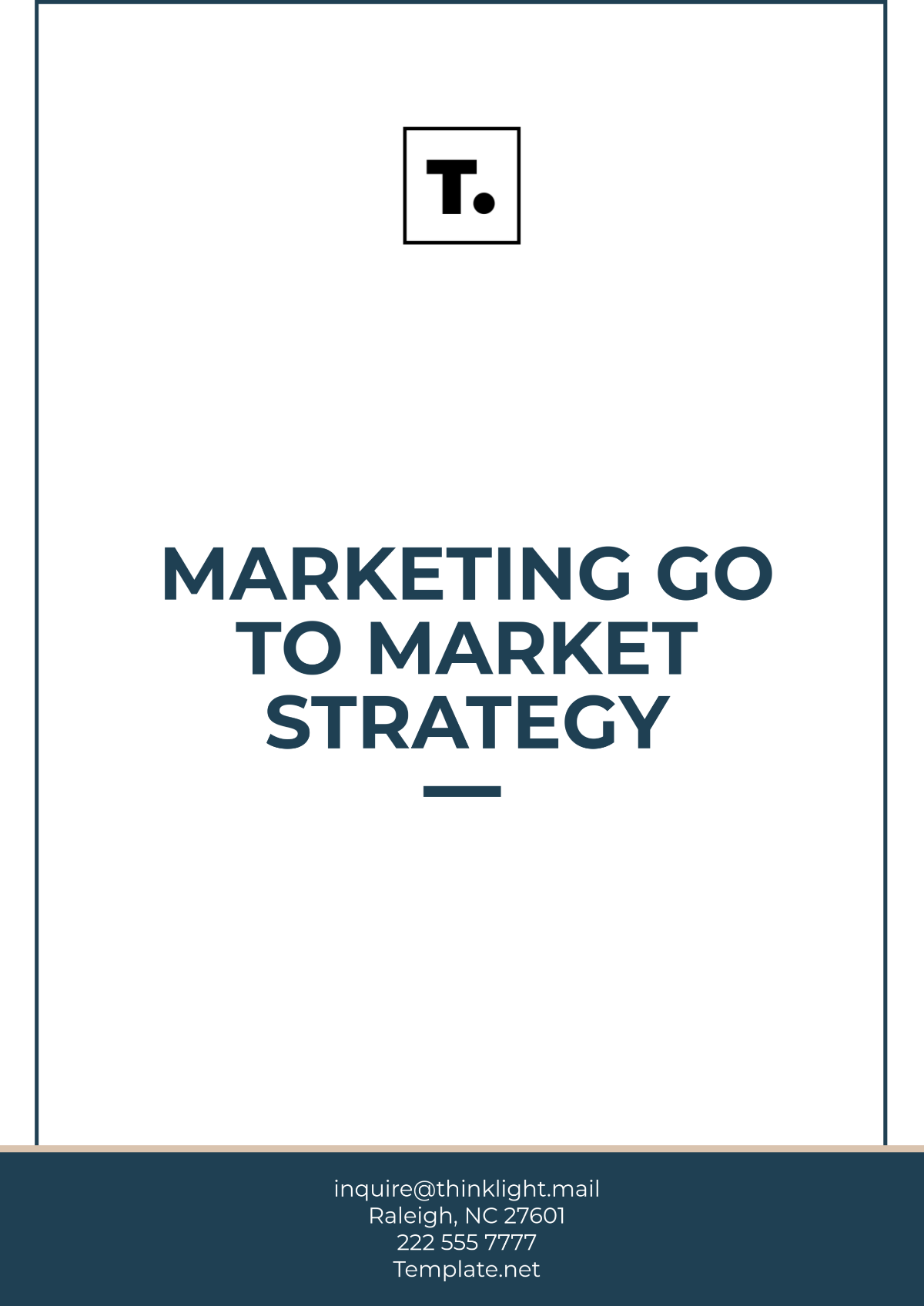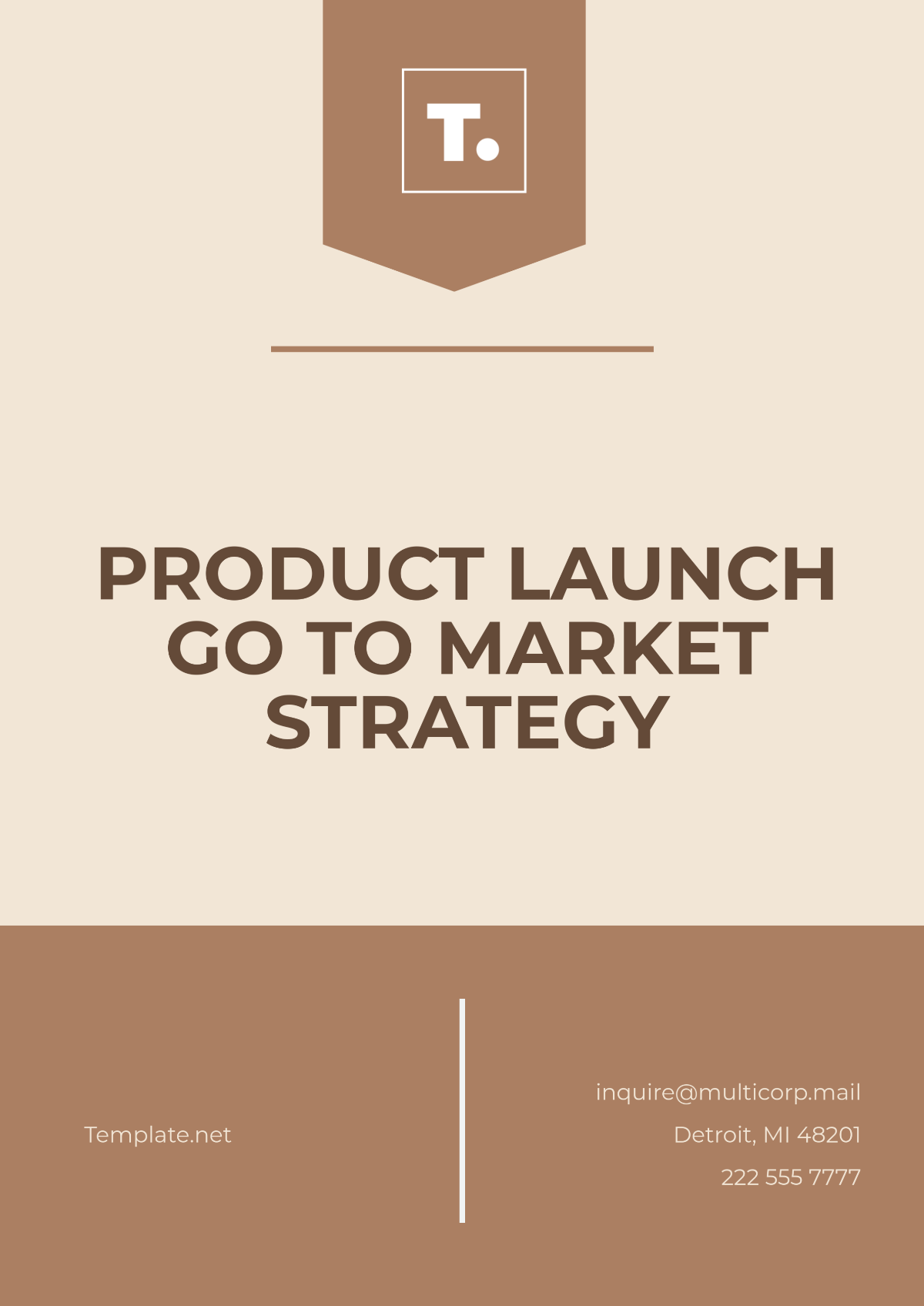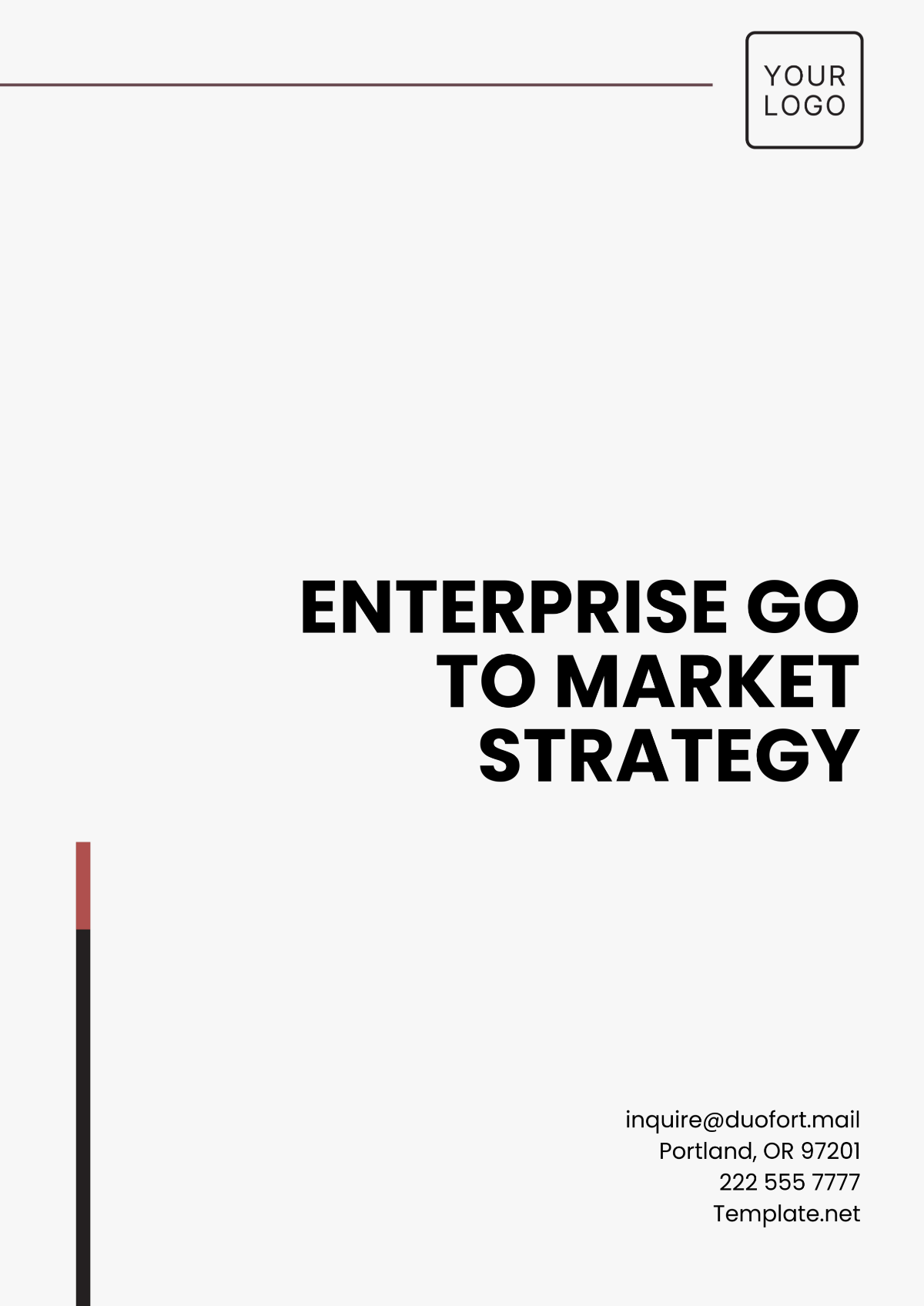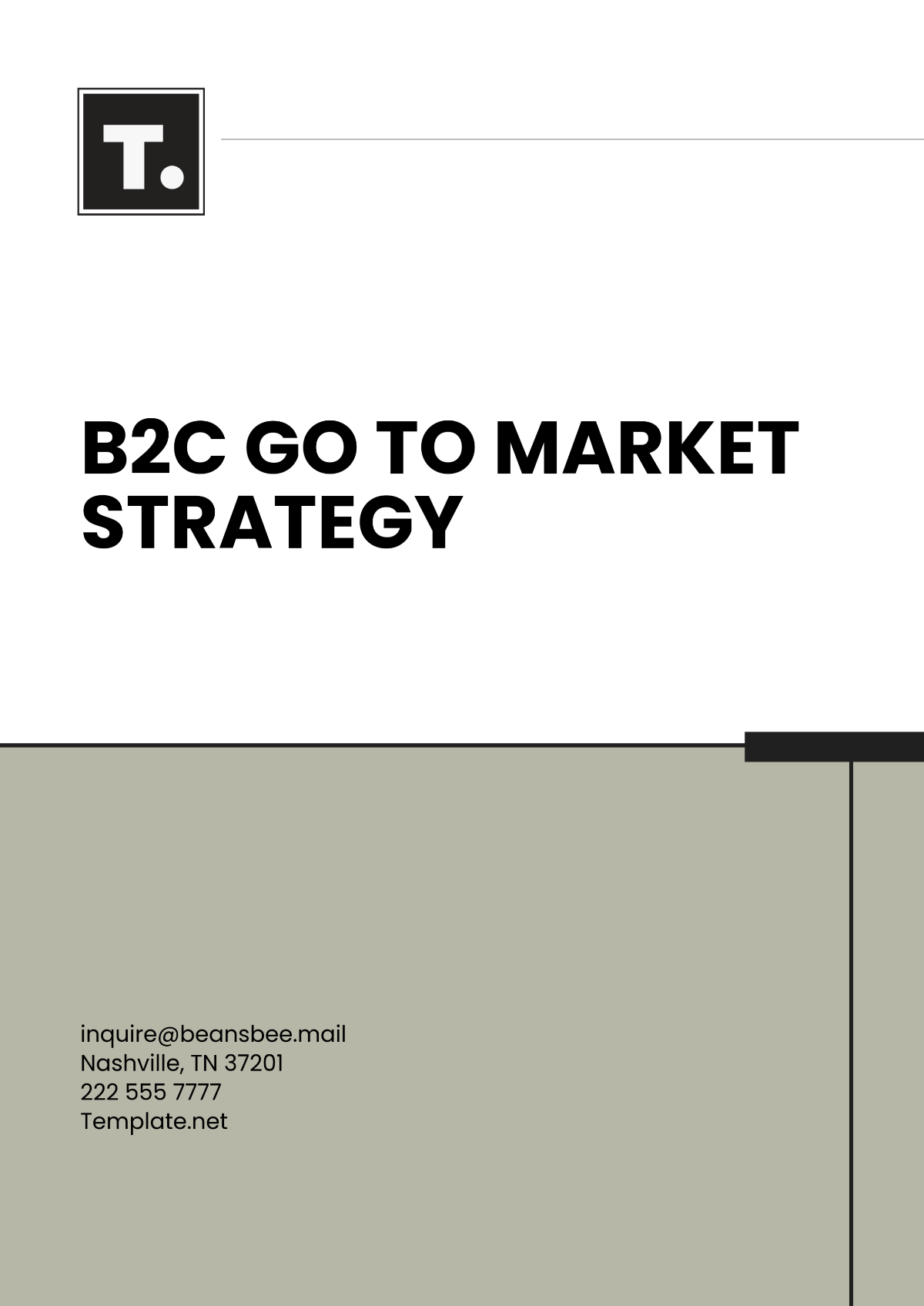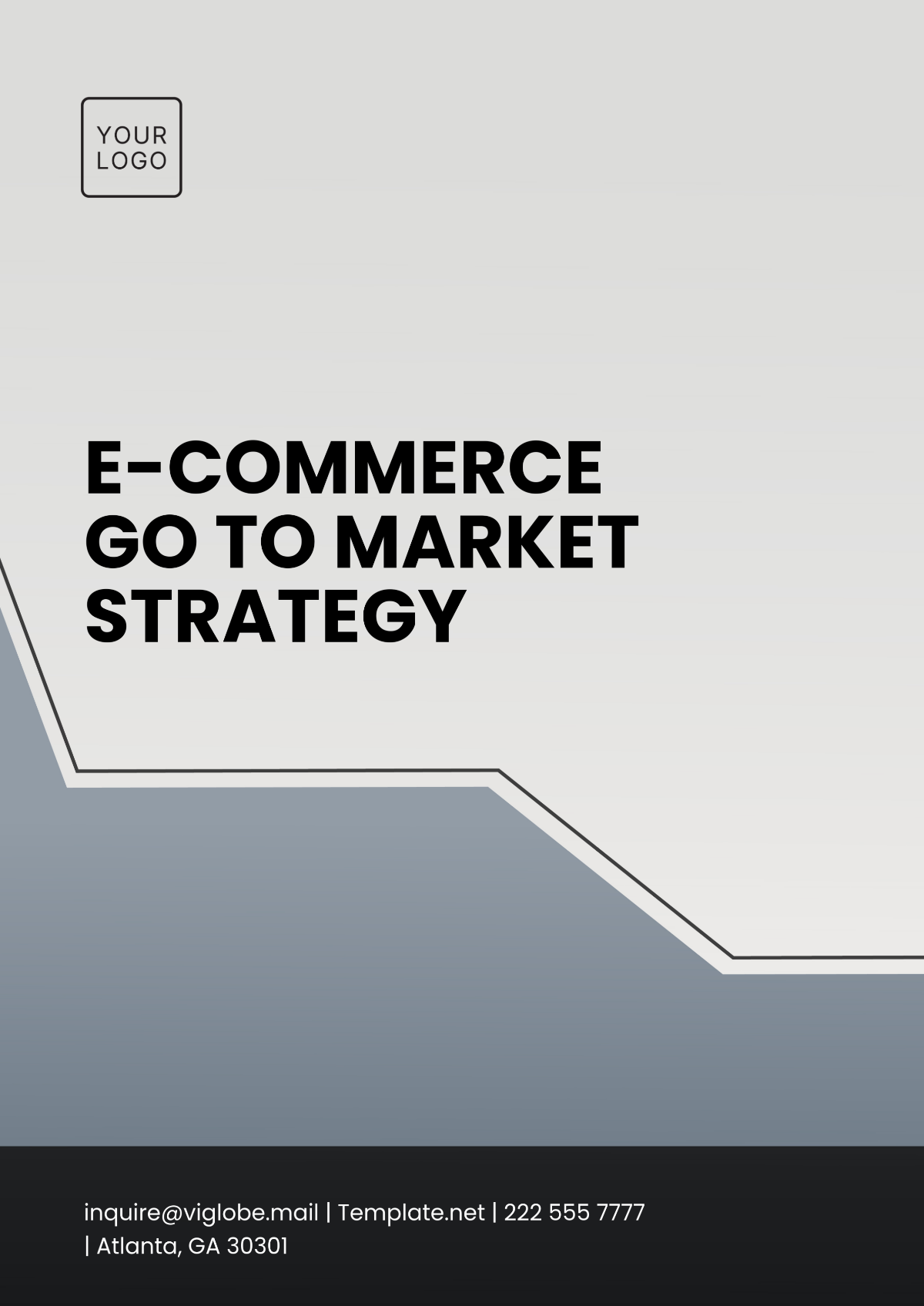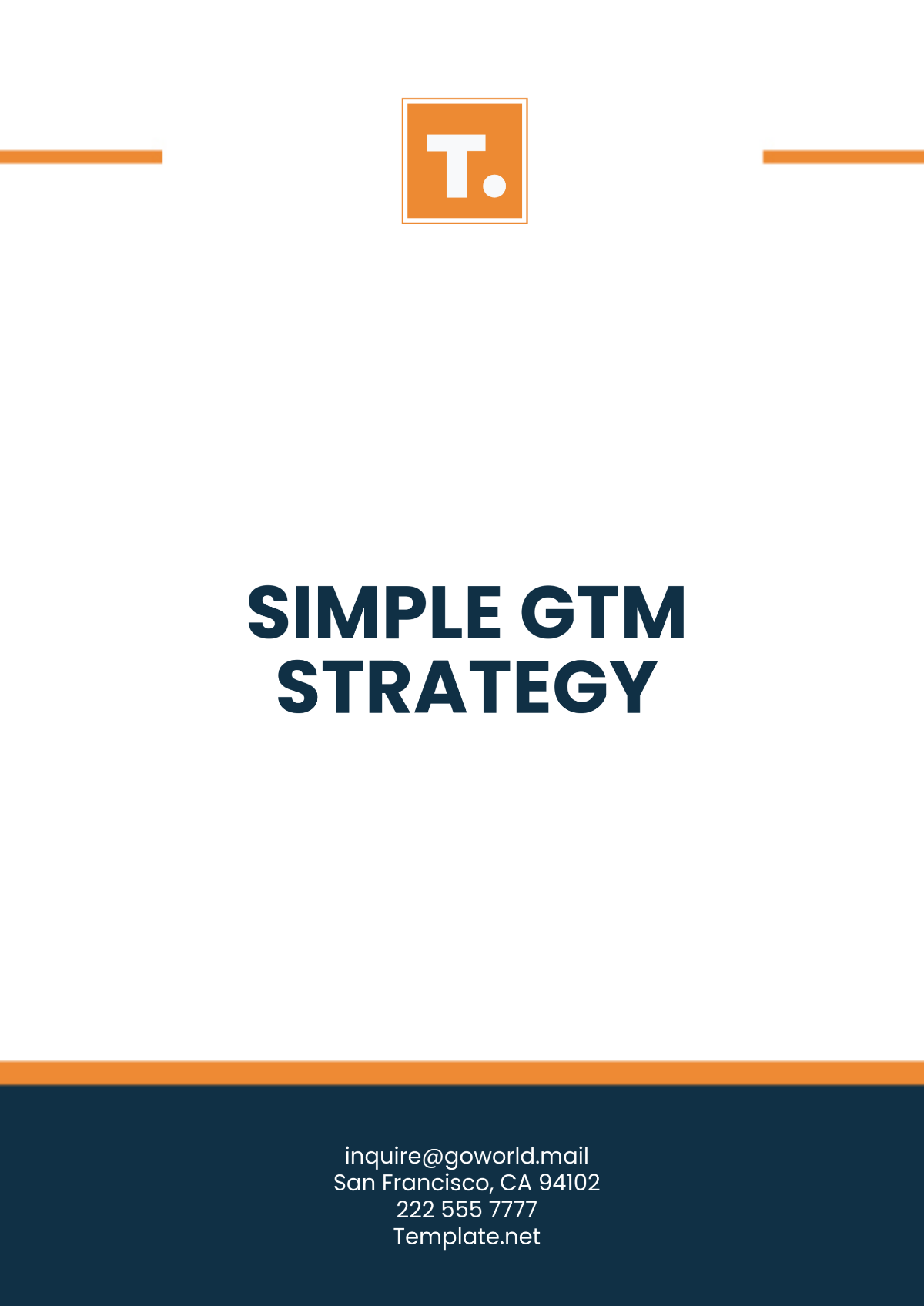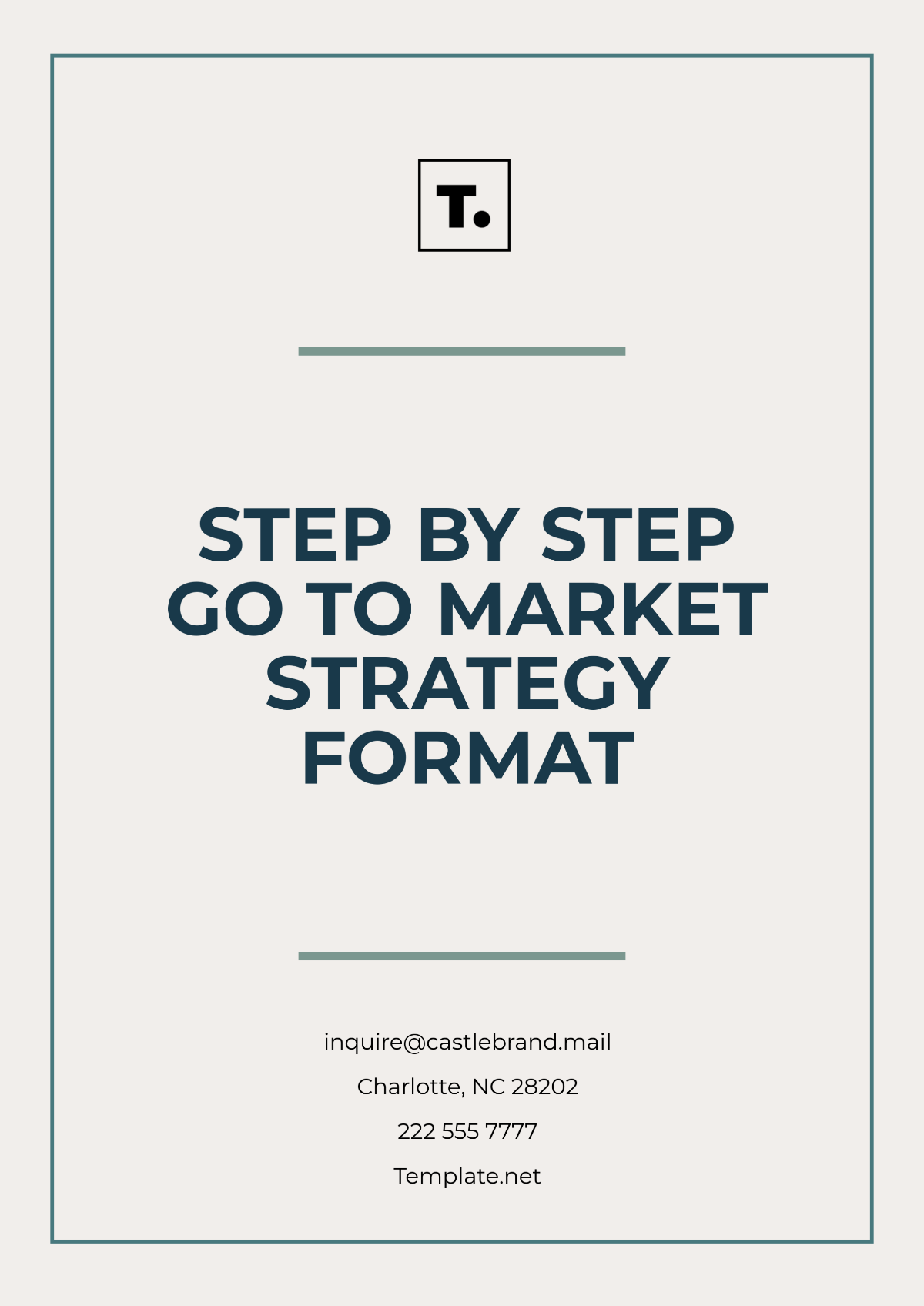Go-to-Market Product Development Strategy
1. Introduction
1.1 Purpose of the Document
The purpose of this document is to outline a comprehensive Go-to-Market (GTM) Product Development Strategy for [Your Company Name]. This strategy will focus on our approach to launching innovative products effectively in the competitive landscape of the future. By detailing the steps and considerations necessary for product development and market introduction, this document serves as a roadmap to guide our organization from the initial stages of product conception to successful market entry and subsequent growth phases.
The GTM strategy is not merely a checklist but a dynamic framework designed to adapt to changing market conditions and customer preferences. Therefore, the goals outlined in this document will serve to enhance [Your Company Name]'s competitive positioning and drive sustainable growth.
1.2 Scope
This document encompasses various aspects of product development, including market analysis, product vision, GTM strategies, operational plans, and metrics for success. It applies to all product lines developed by [Your Company Name] and addresses the evolving landscape of consumer needs and technological advancements. The focus will extend beyond product introduction, aiming for a comprehensive understanding of the market and the lifecycle of the product.
By including strategic objectives and detailed tactics, this GTM strategy ensures alignment across departments and stakeholders, fostering collaboration and coordination as we move forward. The scope also emphasizes the importance of continuous monitoring and adaptation to external factors, ensuring our strategy remains relevant.
1.3 Audience
The primary audience for this document includes:
Executive Leadership: Senior management needs to understand the strategic direction and decision-making processes behind the product launches.
Product Development Teams: They must align product goals with market needs and be aware of the expectations and methodologies outlined in this strategy.
Marketing and Sales Teams: Their roles are crucial in the implementation of the strategy, requiring a clear understanding of target markets and promotional efforts.
Stakeholders and Investors: They require transparency in strategic initiatives and product development to assess potential returns and growth opportunities.
By addressing the interests and needs of these diverse audiences, the document promotes a shared vision and ensures that all parties are informed and engaged throughout the product development process.
1.4 Methodology
The development of this GTM Product Development Strategy is based on extensive market research, competitive analysis, and internal assessments. The methodology encompasses:
Market Research: Conducting market surveys, interviews, and focus groups to gather insights directly from consumers. Understanding their preferences and pain points will help shape our product development initiatives.
Competitive Analysis: Analyzing competitors' strategies, product offerings, and market performance metrics to identify opportunities and threats. This includes benchmarking against industry standards and best practices.
Industry Reports: Leveraging data from industry reports and market forecasts to inform strategic decisions. By understanding the macroeconomic factors influencing the industry, we can better position our products.
Cross-Functional Engagement: Involving stakeholders from various departments, such as R&D, marketing, finance, and sales, to ensure a holistic approach to product development and market introduction.
2. Market Analysis
2.1 Industry Overview
The industry landscape is continually evolving, particularly with advancements in technology and shifts in consumer behavior. As we look ahead, industries such as technology, healthcare, and sustainable products will have undergone significant transformations. The rise of Artificial Intelligence (AI), Internet of Things (IoT), and renewable energy sources is reshaping how products are developed, marketed, and consumed.
According to recent reports, the global market is projected to reach a staggering $15,000 billion by 2075, driven primarily by technological advancements and increased consumer demand for sustainable and innovative solutions. Companies that harness these technologies will not only improve their operational efficiency but also deliver enhanced value to consumers.
Key industry statistics highlight the anticipated growth trajectory:
Year | Industry Growth Rate (%) | Market Size |
|---|---|---|
2050 | [5.6] | [$3,000] |
2055 | [7.2] | [$4,500] |
2060 | [8.5] | [$6,500] |
2065 | [9.0] | [$9,000] |
2070 | [10.2] | [$12,000] |
2075 | [11.5] | [$15,000] |
This upward trajectory emphasizes the importance of timely and strategic product launches to capitalize on emerging opportunities. As market dynamics evolve, [Your Company Name] must remain agile and responsive to industry shifts.
2.2 Target Market Identification
Identifying the target market is critical for the success of any product launch. For [Your Company Name], the target market will include diverse segments characterized by distinct demographic, psychographic, and behavioral traits. Understanding these segments enables tailored marketing strategies and product development initiatives that resonate with consumers.
Demographic Segmentation focuses on factors such as age, gender, income level, and education. Research indicates that the largest demographic segments for our products include Millennials and Generation Z, who are known for their digital savviness and demand for sustainable products.
Psychographic Segmentation delves into consumers' lifestyles, values, and interests. Our research has identified that consumers are increasingly seeking products that align with their values, particularly in terms of environmental sustainability and social responsibility.
Behavioral Segmentation evaluates consumers' purchasing behavior, brand loyalty, and usage rates. Analyzing these behaviors can help [Your Company Name] devise effective marketing strategies that encourage repeat purchases and foster brand loyalty.
Based on extensive market research, the primary target segments for [Your Company Name] include:
Segment | Description | Size ($ Billion) |
|---|---|---|
Millennials | Individuals aged 25-40, tech-savvy, and eco-conscious. | [$4,000] |
Gen Z | Individuals aged 18-24, digital natives, and trendsetters. | [$2,500] |
Professionals | Mid to high-income individuals, seeking convenience and quality. | [$5,000] |
Each of these segments presents unique opportunities and challenges. By aligning our product offerings with the preferences of these target markets, we can maximize our chances for successful launches.
2.3 Competitive Analysis
Conducting a thorough competitive analysis helps [Your Company Name] to understand its position in the market. The analysis will involve identifying key competitors, assessing their strengths and weaknesses, and understanding their market share.
Key Competitors in our industry landscape include:
Competitor | Strengths | Weaknesses |
|---|---|---|
Company A | Strong brand recognition, extensive distribution network, and well-established customer base. | High pricing strategy limiting market access, particularly for budget-conscious consumers. |
Company B | Innovative products, strong R&D capabilities, and a focus on sustainability. | Limited market presence in certain regions, which could impact growth potential. |
Company C | Cost-effective solutions, a robust online presence, and effective digital marketing strategies. | Lower product quality affecting customer satisfaction, leading to potential brand dilution. |
By evaluating these competitors, [Your Company Name] can identify gaps in the market, develop strategies to leverage its unique strengths, and mitigate the risks posed by competitive pressures. This analysis will also inform product positioning and marketing strategies.
2.4 Market Trends
Understanding market trends is crucial for positioning [Your Company Name] effectively in the competitive landscape. Several key trends will influence product development and GTM strategies in the coming years:
Sustainability: There is an increasing consumer demand for eco-friendly and sustainable products. Consumers are actively seeking brands that prioritize environmental responsibility and ethical practices. As a result, [Your Company Name] must integrate sustainability into its product development processes, from sourcing raw materials to manufacturing and packaging.
Digital Transformation: The accelerated adoption of digital technologies and e-commerce has revolutionized how consumers interact with brands. Online shopping is expected to continue growing, necessitating a robust digital presence and a seamless online purchasing experience for our customers.
Personalization: Consumers are increasingly expecting personalized products and services tailored to their individual preferences. Utilizing data analytics and AI, [Your Company Name] can develop customized product offerings that cater to specific consumer needs and preferences.
Health and Wellness: There is a rising interest in products that promote health and well-being, especially in light of recent global health events. Consumers are more focused on their health than ever before, creating opportunities for products that enhance physical and mental wellness.
By staying ahead of these trends and adapting our strategies accordingly, [Your Company Name] can ensure that its products remain relevant and appealing to consumers.
3. Product Development Strategy
3.1 Product Vision and Objectives
The product vision is a guiding principle that informs all aspects of product development at [Your Company Name]. The vision for our upcoming products is to create innovative solutions that not only meet consumer needs but also contribute positively to society and the environment.
Objectives of the product development strategy include:
Innovation: Foster a culture of innovation that encourages creativity and new ideas within product teams. This includes regular brainstorming sessions, innovation workshops, and collaboration with external partners.
Quality: Maintain high-quality standards throughout the product development process. Implement robust quality assurance protocols to ensure that every product meets the established specifications and consumer expectations.
Time-to-Market: Reduce time-to-market by streamlining product development processes. Employ agile methodologies to enhance flexibility and responsiveness in product development cycles.
Market Relevance: Ensure that all products align with market needs and trends. Regularly engage with customers to gather feedback and validate product concepts before full-scale development.
By adhering to these objectives, [Your Company Name] aims to deliver products that resonate with consumers and establish a competitive edge in the market.
3.2 Product Lifecycle Management
Effective product lifecycle management (PLM) is essential for optimizing the development, launch, and ongoing management of products. [Your Company Name] will implement a structured PLM process that includes:
Concept Development: Generating ideas for new products based on market research and consumer insights. This phase involves ideation sessions, prototyping, and initial feasibility assessments.
Product Design: Collaborating with designers and engineers to develop detailed product specifications and designs. This phase includes user testing to ensure that the product is user-friendly and meets consumer expectations.
Production: Selecting appropriate manufacturing processes and suppliers. Implementing lean manufacturing principles will help minimize waste and reduce costs during production.
Launch and Marketing: Developing a comprehensive launch plan that includes marketing strategies, promotional activities, and sales training. The launch phase is critical for creating buzz and driving initial sales.
Post-Launch Evaluation: Analyzing product performance post-launch to identify areas for improvement. Gathering consumer feedback and performance metrics will guide future product iterations and enhancements.
A well-structured PLM process will ensure that [Your Company Name] can efficiently manage products from conception through retirement, maximizing their profitability and impact in the market.
3.3 Innovation and Technology Integration
Integrating innovation and technology into product development is vital for maintaining a competitive edge. [Your Company Name] will leverage the latest technological advancements to enhance product features and capabilities. Key initiatives include:
Research and Development (R&D): Invest in R&D to explore new technologies and materials that can be incorporated into products. This may involve collaboration with research institutions and technology partners to access cutting-edge innovations.
Data Analytics: Utilize data analytics tools to gain insights into consumer preferences and market trends. By analyzing customer data, [Your Company Name] can identify opportunities for product innovation and optimization.
Prototyping and Testing: Implement advanced prototyping techniques, such as 3D printing and virtual simulations, to accelerate the design process and test product concepts before full-scale production.
Feedback Loops: Establish feedback loops with customers to gather input on product performance and features. Utilizing digital platforms will facilitate real-time feedback, enabling rapid iterations based on user insights.
By prioritizing innovation and technology integration, [Your Company Name] will remain at the forefront of industry advancements and continuously deliver cutting-edge products to consumers.
4. Go-to-Market Strategy
4.1 Pricing Strategy
Pricing is a critical component of the GTM strategy, impacting profitability, market penetration, and overall brand positioning. The pricing strategy for [Your Company Name] will encompass the following elements:
Cost-Plus Pricing: Calculate the total cost of production and add a markup percentage to determine the selling price. This approach ensures that all costs are covered while achieving desired profit margins.
Value-Based Pricing: Assess the perceived value of the product to consumers and price accordingly. This method allows [Your Company Name] to capture value based on the unique features and benefits offered by the product.
Dynamic Pricing: Implement dynamic pricing strategies that allow for flexibility based on market conditions, demand fluctuations, and competitive pricing. This will enable [Your Company Name] to respond quickly to changes in the market.
Pricing Strategy | Description | Expected Outcome |
|---|---|---|
Cost-Plus Pricing | Set price based on production costs plus markup. | Ensures cost recovery and profit generation. |
Value-Based Pricing | Price based on perceived consumer value. | Maximizes revenue potential and brand positioning. |
Dynamic Pricing | Adjust prices based on real-time market data. | Increases competitiveness and market responsiveness. |
By implementing a balanced pricing strategy that considers costs, consumer perceptions, and market dynamics, [Your Company Name] can achieve optimal pricing that drives sales while maintaining profitability.
4.2 Distribution Channels
Selecting the right distribution channels is essential for ensuring product availability and accessibility to consumers. [Your Company Name] will adopt a multi-channel distribution strategy that includes:
Direct Sales: Establish a direct-to-consumer sales model through [Your Company Name]'s e-commerce platform. This approach allows for better control over customer experience and higher profit margins.
Retail Partnerships: Collaborate with established retailers to leverage their distribution networks. This includes negotiating shelf space, promotional opportunities, and co-branding initiatives.
Wholesale Distribution: Utilize wholesale distributors to reach a broader audience, especially in regions where direct sales may not be feasible. Wholesale partnerships can facilitate bulk sales and expand market reach.
Distribution Channel | Description | Advantages |
|---|---|---|
Direct Sales | Sell products directly through the company's website. | Greater control over customer experience and pricing. |
Retail Partnerships | Partner with retail chains for in-store sales. | Access to established customer bases and marketing support. |
Wholesale Distribution | Collaborate with wholesalers for bulk sales. | Increased market reach and efficiency in distribution. |
By implementing a diversified distribution strategy, [Your Company Name] can maximize product availability and meet consumer demand effectively.
4.3 Marketing and Promotion Strategy
A well-defined marketing and promotion strategy will create awareness and generate excitement around [Your Company Name]'s products. Key components of the strategy include:
Integrated Marketing Communications (IMC): Develop an IMC strategy that ensures consistent messaging across all marketing channels, including digital, print, and social media. This cohesive approach strengthens brand identity and enhances customer engagement.
Content Marketing: Create valuable and informative content that resonates with target audiences. This includes blog posts, videos, and webinars that educate consumers about product benefits and establish [Your Company Name] as an industry thought leader.
Social Media Marketing: Utilize social media platforms to engage with consumers and build brand loyalty. Targeted ad campaigns can drive traffic to the website and generate leads for sales teams.
Public Relations (PR): Implement a robust PR strategy to generate media coverage and create buzz around product launches. This includes press releases, media events, and influencer partnerships to amplify product visibility.
Marketing Strategy | Description | Expected Outcome |
|---|---|---|
Integrated Marketing Communications (IMC) | Consistent messaging across all channels. | Strengthened brand identity and enhanced customer engagement. |
Content Marketing | Create valuable content for target audiences. | Established industry authority and increased consumer trust. |
Social Media Marketing | Engage consumers through targeted campaigns. | Improved brand visibility and customer interaction. |
Public Relations (PR) | Generate media coverage and product buzz. | Increased awareness and credibility in the market. |
By implementing a comprehensive marketing and promotion strategy, [Your Company Name] will effectively engage consumers and drive demand for its products.
4.4 Sales Strategy
An effective sales strategy is critical for converting leads into customers and achieving sales targets. [Your Company Name] will focus on the following components:
Sales Training: Develop training programs for sales teams to enhance product knowledge and selling skills. This includes role-playing scenarios, product demonstrations, and continuous education on market trends.
Customer Relationship Management (CRM): Implement a CRM system to manage customer interactions, track sales leads, and improve forecasting accuracy. This technology enables sales teams to nurture relationships and provide personalized support.
Incentive Programs: Create incentive programs to motivate sales teams and reward high performance. This may include commission structures, bonuses for meeting targets, and recognition programs that foster a competitive yet collaborative environment.
Sales Strategy | Description | Expected Outcome |
|---|---|---|
Sales Training | Enhance product knowledge and selling skills. | Improved sales performance and customer satisfaction. |
Customer Relationship Management (CRM) | Manage customer interactions and sales leads. | Increased efficiency in sales processes and relationship management. |
Incentive Programs | Motivate sales teams with rewards and recognition. | Higher morale and improved sales results. |
By focusing on these key components, [Your Company Name] will create a high-performing sales organization capable of achieving ambitious revenue goals.
5. Operational Plan
5.1 Resource Allocation
Efficient resource allocation is critical to executing the GTM strategy effectively. [Your Company Name] will ensure that resources are allocated optimally across various functions, including:
Human Resources: Hire additional staff to support product development, marketing, and sales initiatives. This includes recruiting talent with expertise in product design, marketing analytics, and sales strategy.
Financial Resources: Allocate a sufficient budget for R&D, marketing campaigns, and distribution. This ensures that all departments have the financial backing needed to execute their respective strategies.
Technology Investments: Invest in advanced technologies to enhance productivity and streamline operations. This may include upgrading IT infrastructure, adopting new software solutions, and implementing automation in production processes.
Resource Type | Description | Allocation Strategy |
|---|---|---|
Human Resources | Hire skilled personnel for product development and marketing. | Identify key roles and recruit top talent. |
Financial Resources | Allocate budget for R&D, marketing, and distribution. | Prioritize initiatives with the highest ROI potential. |
Technology Investments | Invest in technology for operational efficiency. | Research and adopt cutting-edge solutions to improve productivity. |
By ensuring efficient resource allocation, [Your Company Name] can maximize its operational effectiveness and drive successful product launches.
5.2 Team Structure
A well-defined team structure will facilitate collaboration and communication across departments. [Your Company Name] will adopt the following organizational structure:
Product Development Team: Composed of product managers, designers, and engineers responsible for the product development lifecycle. This team will collaborate closely with marketing to ensure that products align with market needs.
Marketing Team: Responsible for executing marketing campaigns, content creation, and customer engagement strategies. This team will work in conjunction with the sales team to drive product awareness and demand.
Sales Team: Focused on converting leads into customers and achieving sales targets. This team will leverage CRM tools to manage customer relationships and track performance metrics.
Team Structure | Description | Key Responsibilities |
|---|---|---|
Product Development Team | Manages product lifecycle from concept to launch. | Conducts market research, designs products, and coordinates with marketing. |
Marketing Team | Executes marketing strategies and campaigns. | Creates content, manages social media, and generates leads. |
Sales Team | Converts leads into customers and achieves sales goals. | Engages with customers, manages sales pipelines, and reports performance. |
By establishing a clear team structure, [Your Company Name] can enhance collaboration and ensure that all teams are aligned towards common goals.
5.3 Risk Management
Identifying and managing risks is crucial to the successful execution of the GTM strategy. [Your Company Name] will implement a comprehensive risk management framework that includes:
Risk Assessment: Conduct regular assessments to identify potential risks associated with product development, market entry, and operational processes. This includes financial, operational, and reputational risks.
Mitigation Strategies: Develop strategies to mitigate identified risks. This may involve contingency planning, diversifying suppliers, and establishing protocols for addressing unforeseen challenges.
Monitoring and Review: Continuously monitor the effectiveness of risk management strategies and make necessary adjustments. Regular reviews will ensure that the organization remains proactive in addressing emerging risks.
Risk Management Component | Description | Actions |
|---|---|---|
Risk Assessment | Identify potential risks in product development and operations. | Conduct regular risk assessments and audits. |
Mitigation Strategies | Develop strategies to reduce identified risks. | Create contingency plans and diversify suppliers. |
Monitoring and Review | Continuously monitor and adjust risk management strategies. | Conduct regular reviews and update protocols as needed. |
By implementing a robust risk management framework, [Your Company Name] can minimize potential disruptions and ensure the successful execution of its product development and GTM strategies.
6. Metrics for Success
6.1 Key Performance Indicators (KPIs)
Establishing KPIs is essential for measuring the success of the GTM strategy. [Your Company Name] will track the following KPIs to evaluate performance:
Sales Revenue: Monitor total sales revenue generated from new product launches. This metric provides insight into the financial success of the products and the effectiveness of sales strategies.
Market Share: Assess changes in market share within the targeted segments. Tracking market share helps determine how well [Your Company Name] is performing relative to competitors.
Customer Acquisition Cost (CAC): Calculate the cost associated with acquiring a new customer. Understanding CAC will help evaluate the efficiency of marketing and sales efforts.
Customer Satisfaction (CSAT): Gather feedback from customers to measure their satisfaction levels with the products. High CSAT scores indicate that products are meeting or exceeding consumer expectations.
KPI | Description | Measurement Frequency |
|---|---|---|
Sales Revenue | Total revenue generated from new product launches. | Monthly |
Market Share | Percentage of market share within targeted segments. | Quarterly |
Customer Acquisition Cost | Cost associated with acquiring a new customer. | Monthly |
Customer Satisfaction | Measure of customer satisfaction with products. | Bi-annual |
By tracking these KPIs, [Your Company Name] can gain valuable insights into the effectiveness of its strategies and make data-driven decisions to enhance performance.
6.2 Feedback Mechanisms
Establishing feedback mechanisms is crucial for continuous improvement and product optimization. [Your Company Name] will implement the following feedback channels:
Customer Surveys: Conduct regular surveys to gather feedback on product performance, features, and overall satisfaction. This direct input from customers will inform future product iterations and enhancements.
Focus Groups: Organize focus groups with target customers to discuss product experiences and gather qualitative insights. This approach allows for in-depth exploration of consumer preferences and pain points.
Social Media Monitoring: Monitor social media channels for customer feedback and sentiment analysis. Engaging with customers on social platforms enables real-time responses and fosters community engagement.
Feedback Mechanism | Description | Purpose |
|---|---|---|
Customer Surveys | Gather quantitative feedback on products. | Inform product development and marketing strategies. |
Focus Groups | Organize discussions with target customers. | Explore qualitative insights and consumer preferences. |
Social Media Monitoring | Track customer feedback on social platforms. | Engage with customers and address concerns promptly. |
By implementing these feedback mechanisms, [Your Company Name] can continuously refine its products and strategies, ensuring alignment with consumer needs and preferences.
7. Conclusion
The Go-to-Market Product Development Strategy for [Your Company Name] is designed to provide a comprehensive framework for successfully launching innovative products in an increasingly competitive landscape. By focusing on detailed market analysis, a structured product development process, and effective GTM strategies, [Your Company Name] is positioned to achieve sustainable growth and enhance its market presence.
Key takeaways from this strategy include:
The importance of understanding market dynamics and consumer preferences in shaping product offerings.
The necessity of fostering a culture of innovation and leveraging technology for product development.
The critical role of a well-defined marketing and sales strategy in driving product awareness and customer engagement.
The need for efficient resource allocation and risk management to ensure operational effectiveness.
By implementing this strategy, [Your Company Name] will not only meet the demands of the market but also exceed consumer expectations, ultimately leading to long-term success in the industry.






